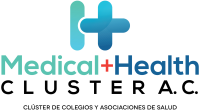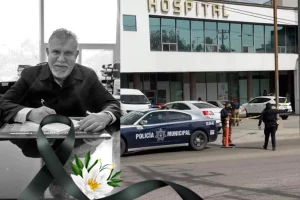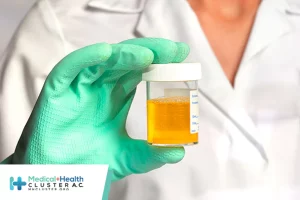CONDENA MH CLÚSTER ATAQUE ARMADO A HOSPITAL ARCÁNGELES
Leer más
The COVID-19 Pandemic Rages on for People Who Are Immunocompromised

anet Handal, who has taken immunosuppressive drugs since her 2010 kidney transplant, hasn’t exactly been impressed by public health messaging about COVID-19.
A medical assistant at a University of Washington Medicine clinic prepares a 2-shot dose of a monoclonal antibody therapy that can help prevent SARS-CoV-2 infection among people who are immunocompromised.
“The CDC [US Centers for Disease Control and Prevention] has done a bad job with managing the immunocompromised from the get-go,” the 71-year-old Handal, a New York City resident, said in an interview.
Take the CDC’s decision in May 2021 to announce that fully vaccinated individuals no longer needed to wear face masks or practice social distancing in most places.
In a video in which she discussed the policy change, CDC Director Rochelle Walensky, MD, MPH, did mention once that people who were immunocompromised should check with their physician before doffing their masks, but she repeatedly said that everyone who was fully vaccinated could do so.
Handal, who created a Facebook group about vaccines and organ transplants that has more than 2000 members and founded the Transplant Recipients and Immunocompromised Patient Advocacy Group, said she knows at least 1 fully vaccinated individual with a compromised immune system who listened to the CDC, took off their mask, contracted COVID-19, and died.
Handal’s point is that many of the millions of people in the US with compromised immune systems have felt like an afterthought during the pandemic. And yet, they—organ transplant recipients taking antirejection drugs, cancer patients receiving active treatment, and people with primary immunodeficiency, to name a few—are the ones whose immune systems are least likely to mount an effective response to vaccines or vanquish SARS-CoV-2 if they’re infected.
More than 2 years into the pandemic, mask and vaccine mandates are a thing of the past in most places. Floor decals in some checkout lines and store aisles still mark 6-foot segments, but no one seems to pay much attention to social distancing anymore.
Since the rollback of nonpharmaceutical interventions to limit the spread of SARS-CoV-2, “it’s getting more dangerous” for individuals who are immunocompromised, transplant surgeon Dorry Segev, MD, PhD, director of the Center for Surgical and Transplant Applied Research at NYU Langone Health, noted in an interview.
To help protect people with compromised immune systems, the US Food and Drug Administration in December authorized a combination of 2 anti–SARS-CoV-2 monoclonal antibodies, tixagevimab and cilgavimab (Evusheld), for preexposure prophylaxis (PrEP). But some candidates for the treatment, as well as some of their physicians, still don’t know who should get it.
“The recently developed government website for comprehensive COVID-19 community guidance contains information about masks, vaccines, treatment, and testing but does not include information about tixagevimab/cilgavimab,” Harvard Medical School infectious disease specialist Camille Kotton, MD, pointed out in an April 12 opinion piece in the Annals of Internal Medicine.
“Belt and Suspenders”
For people who are moderately to severely immunocompromised, protection against SARS-CoV-2 isn’t either a vaccine or PrEP.
“We call it a belt and suspenders strategy,” said Myron Cohen, MD, director of the University of North Carolina Institute for Global Health and Infectious Diseases in Chapel Hill and a leader of the National Institutes of Health’s COVID-19 Prevention Network, a role in which he has focused on collaborating with industry in the development of monoclonal antibodies.
In other words, both vaccination and PrEP are needed for optimal protection against SARS-CoV-2 infection in people whose immune systems are moderately to severely immunocompromised.
Apparently, though, some physicians haven’t gotten the message. For example, Segev said he recently received an email from a colleague at the University of California, Los Angeles, concerned about a patient with a kidney transplant whose physician thought PrEP monoclonal antibodies were unnecessary after 4 doses of a COVID-19 vaccine.
The federal government purchased tixagevimab and cilgavimab and allocates the combination treatment to state and territorial health departments on a monthly basis; through April, a little more than 1 million doses had been allocated, according to the US Department of Health and Human Services (HHS).
“Right now, we have more Evusheld available than is being ordered by states and territories,” an HHS spokesperson said in an email, noting that the federal government has ordered a total of 1.7 million doses.
But that will be enough to treat only 850 000 people. In late February, the US Food and Drug Administration (FDA) doubled the authorized dose to increase protection against the Omicron variants BA.1 and BA.1.1, thus halving the number of people who could get the treatment. And while the original authorization noted that protection persisted for 6 months, the duration of protection against BA.1 and BA.1.1 might not be that long, according to the FDA. However, when announcing the doubling of the dose, the agency noted that tixagevimab and cilgavimab was expected to have greater neutralizing activity against BA.2—the dominant variant in the US in late April—than against the earlier Omicron subvariants.
“One big problem is that there are no guidelines to help people understand when they are at risk and who needs passive immunity,” Segev explained, calling the FDA’s list of conditions that qualify people for the PrEP monoclonal antibodies “very, very vague.” The FDA itself has said the list isn’t inclusive.
As a result, Segev said, “It would not surprise me at all that there is a wide range of immunocompromised people who are obtaining this agent. The people who know how to navigate the system well are going to be the ones who manage to get hold of this.”
Even when they’re aware that they’re likely to benefit from PrEP for COVID-19, uneven distribution of the treatment has forced some people to go to great lengths, literally, to obtain it. Handal said she knows a Wisconsin family that drove to South Dakota—10 hours each way—so that a family member could get tixagevimab and cilgavimab.
Handal drove 2 hours each way twice—once for her original dose and then, after the FDA doubled the authorized dose, for a catch-up dose—to a hospital near Trenton, New Jersey. Because her transplant wasn’t recent and she was otherwise healthy, she didn’t meet the eligibility criteria at the New York City hospitals that were administering COVID-19 PrEP, she explained.
Although the federal government is paying for the PrEP monoclonal antibodies, Handal said some people are being charged upward of $2000 for the product’s administration, which isn’t always covered by their insurance. “It becomes an equity issue,” she said.
At the University of Alabama Medical Center in Birmingham, “we developed a tiered process to allocate antibodies because we were just not sure how much we would have,” transplant infectious diseases specialist Anoma Nellore, MD, said in an interview.
However, the existing medical infrastructure isn’t designed to distribute monoclonal antibodies en masse, Nellore noted. “I am in a state with a large rural population. It is unfortunate, but…tertiary centers have a bit of an advantage.”
In addition, she said, public health messaging on the national and community levels needs to make clear that PrEP is helpful in preventing SARS-CoV-2 infection among those who are immunocompromised.
Because at the other end of the spectrum from people who drive long distances to obtain PrEP are “plenty of people who don’t want to bother with it, just like with vaccines,” infectious disease specialist Shira Abeles, MD, of UC San Diego Health, said in an interview. “We did do targeted text messaging. A lot of the most at-risk [patients] are very identifiable” through registries and transplant centers.
To Test or Not to Test?
Not everyone thought to be moderately or severely immunocompromised responds poorly or not at all to COVID-19 vaccines, which is why Segev has been quite vocal in urging the use of antispike antibody tests to identify those who most need PrEP.
“In general, my recommendation is for all transplant patients to get antibody testing” after vaccination against COVID-19, he said.
However, Segev noted, antibody testing in that population is “dishearteningly variable.”
Neither the FDA nor the major transplant professional organizations recommend it. Failure to mount any detectable antibody response to the SARS-CoV-2 spike protein is “concerning for increased risk for COVID-19 acquisition, especially with more transmissible variants,” the transplant groups acknowledge. However, they note, the absence of measurable antibodies doesn’t necessarily mean an individual hasn’t mounted a cellular response to the COVID-19 vaccine. Plus, the groups say, there’s no consensus about what level of antibodies is protective.
“We don’t have a good and regularly available surrogate of immunity,” Cohen said. “The main strategy is kind of keep vaccinating and hope for the best.”
To determine a surrogate of immunity, researchers are trying to correlate antibody titers in blood with what’s happening clinically, he said, adding that many companies are working on developing a rapid antibody test.
Individual physicians and patients may decide they want to do antibody testing; if so, they need to discuss how to interpret the result in light of the local prevalence of SARS-CoV-2, the patient’s own level of immunosuppression, and other pertinent factors, the transplant organizations say.
Handal, who has a genetic disorder that led to kidney failure, has taken antibody tests after each of her 4 vaccine doses and her 2 doses of PrEP. She participated in an observational study coauthored by Segev that checked antibody levels of 658 solid organ transplant recipients after their first 2 doses of a messenger RNA (mRNA) vaccine.
At a median of 21 days after their first dose, antibody was detected in only 98 participants (15%); at a median of 29 days after their second dose, antibody was detected in 357 participants (54%), Segev and coauthors reported in a June 2021 research letter in JAMA.
Handal was 1 of 259 (39%) study participants who had no antibody response after the first vaccine dose but did after the second. But, she said, her antibody level was only 5 U/mL, below the median level of 34.7 U/mL for participants who responded only after the second vaccine dose. Her low level led her to postpone a highly anticipated trip to visit relatives in Texas. “Many people who were immunocompromised had no clue that the vaccines didn’t work for them,” she said.
After her third vaccine dose, though, her antibody level had climbed high enough that she finally felt comfortable flying to Texas, and her titers increased further after her fourth dose and then again after receiving PrEP. Handal said she continues to wear a mask indoors and on the subway, where masks are still required, but she’s not sure when she’ll go back to eating inside restaurants.
“We desperately need more studies,” Nellore said about the use of antibody testing to identify people who’ve had a poor response to COVID-19 vaccines. “That sounds like an easy question, but it isn’t.” The National Institutes of Health needs to fund studies to answer the antibody testing question in real time across multiple research centers, she said.
“It’s incredibly important for this patient population and public health,” Nellore said, noting that variants of concern are more likely to arise in people who are immunocompromised because SARS-CoV-2 replicates in them longer than in people who are immunocompetent.
Meanwhile, “I’m personally counseling all my immunocompromised patients to practice safer living,” said Nellore, who compares receiving a new organ to having a baby. “They do have to be vigilant. They should understand the gravity of the responsibility.”
Créditos: Comité científico Covid




